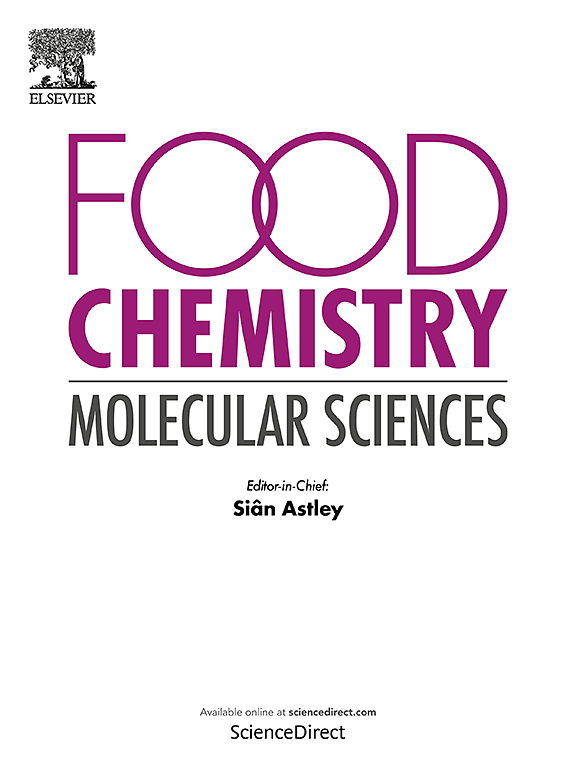酶催化铁观音乌龙茶生产过程中挥发性有机化合物动态变化揭示香气发展的研究
IF 4.1
Q2 FOOD SCIENCE & TECHNOLOGY
引用次数: 0
摘要
为阐明酶催化过程(ECP)中特征香气的形成,采用基于气相色谱-质谱联用仪(GC-MS)的挥发性代谢组学和解吸-电喷雾电离耦合质谱-成像(DESI-MSI)分析了铁观音茶叶中挥发性有机化合物(VOCs)的变化。共获得 579 种挥发性有机化合物,并从中鉴定出涉及五种途径的 24 种成分作为生物标记物。其中,2-呋喃甲酸、4-甲基苯甲醛、N-苄基甲酰胺、积雪草醛等四种挥发性有机化合物在DESI-MSI和GC-MS分析中均被检测到,并表现出随加工步骤的动态变化。RNA 序列分析表明,应激反应基因在茶叶加工过程中被激活,促进了茶叶中花果香气的积累。代谢途径分析表明,花果香相关成分(如挥发性萜类化合物、苯丙酮类/类烯酮、吲哚)的增加,以及绿叶挥发物(包括(E)-2-己烯醛、(Z)-3-己烯醇)的减少,在特征香气的形成过程中发挥了关键作用。本文章由计算机程序翻译,如有差异,请以英文原文为准。
Study on dynamic alterations of volatile organic compounds reveals aroma development over enzymatic-catalyzed process of Tieguanyin oolong tea production
To elucidate the formation of characteristic aroma over enzymatic-catalyzed processes (ECP), GC–MS-based volatile-metabolomic combined with desorption-electrospray-ionization coupled mass-spectrometry-imaging (DESI-MSI) were employed to analyze the changes of volatile organic compounds (VOCs) in Tieguanyin tea. A total of 579 VOCs were obtained, from which 24 components involved in five pathways were identified as biomarkers. Among these, four VOCs including 2-furancarboxylic acid, 4-methylbenzaldehyde, N-benzylformamide, cuminaldehyde, were detected in both DESI-MSI and GC–MS analysis, exhibiting dynamic changes along processing steps. RNA-sequencing analysis indicated the genes referring to stress response were activated during tea processing, facilitating the accumulation of flora-fruity aroma in tea leaf. Metabolic pathways analysis revealed that the increase in floral-fruity related components such as volatile terpenoids, phenylpropanoids/benzenoids, indole, alongside a decrease in green leaf volatiles including (E)-2-Hexenal, (Z)-3-Hexenol, played a crucial role in development of characteristic aroma, which could be a feasible index for evaluating processing techniques or quality of oolong tea.
求助全文
通过发布文献求助,成功后即可免费获取论文全文。
去求助
来源期刊

Food Chemistry Molecular Sciences
Agricultural and Biological Sciences-Food Science
CiteScore
6.00
自引率
0.00%
发文量
83
审稿时长
82 days
期刊介绍:
Food Chemistry: Molecular Sciences is one of three companion journals to the highly respected Food Chemistry.
Food Chemistry: Molecular Sciences is an open access journal publishing research advancing the theory and practice of molecular sciences of foods.
The types of articles considered are original research articles, analytical methods, comprehensive reviews and commentaries.
Topics include:
Molecular sciences relating to major and minor components of food (nutrients and bioactives) and their physiological, sensory, flavour, and microbiological aspects; data must be sufficient to demonstrate relevance to foods and as consumed by humans
Changes in molecular composition or structure in foods occurring or induced during growth, distribution and processing (industrial or domestic) or as a result of human metabolism
Quality, safety, authenticity and traceability of foods and packaging materials
Valorisation of food waste arising from processing and exploitation of by-products
Molecular sciences of additives, contaminants including agro-chemicals, together with their metabolism, food fate and benefit: risk to human health
Novel analytical and computational (bioinformatics) methods related to foods as consumed, nutrients and bioactives, sensory, metabolic fate, and origins of foods. Articles must be concerned with new or novel methods or novel uses and must be applied to real-world samples to demonstrate robustness. Those dealing with significant improvements to existing methods or foods and commodities from different regions, and re-use of existing data will be considered, provided authors can establish sufficient originality.
 求助内容:
求助内容: 应助结果提醒方式:
应助结果提醒方式:


